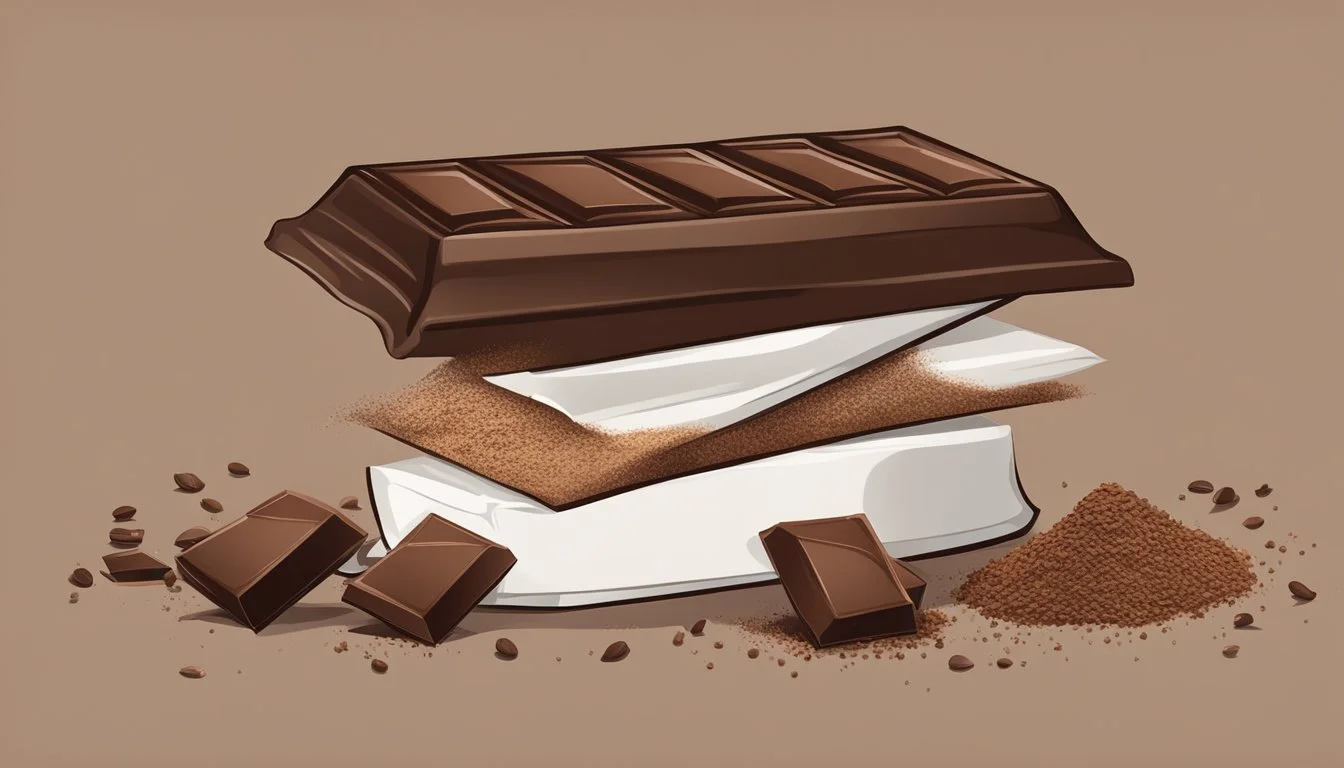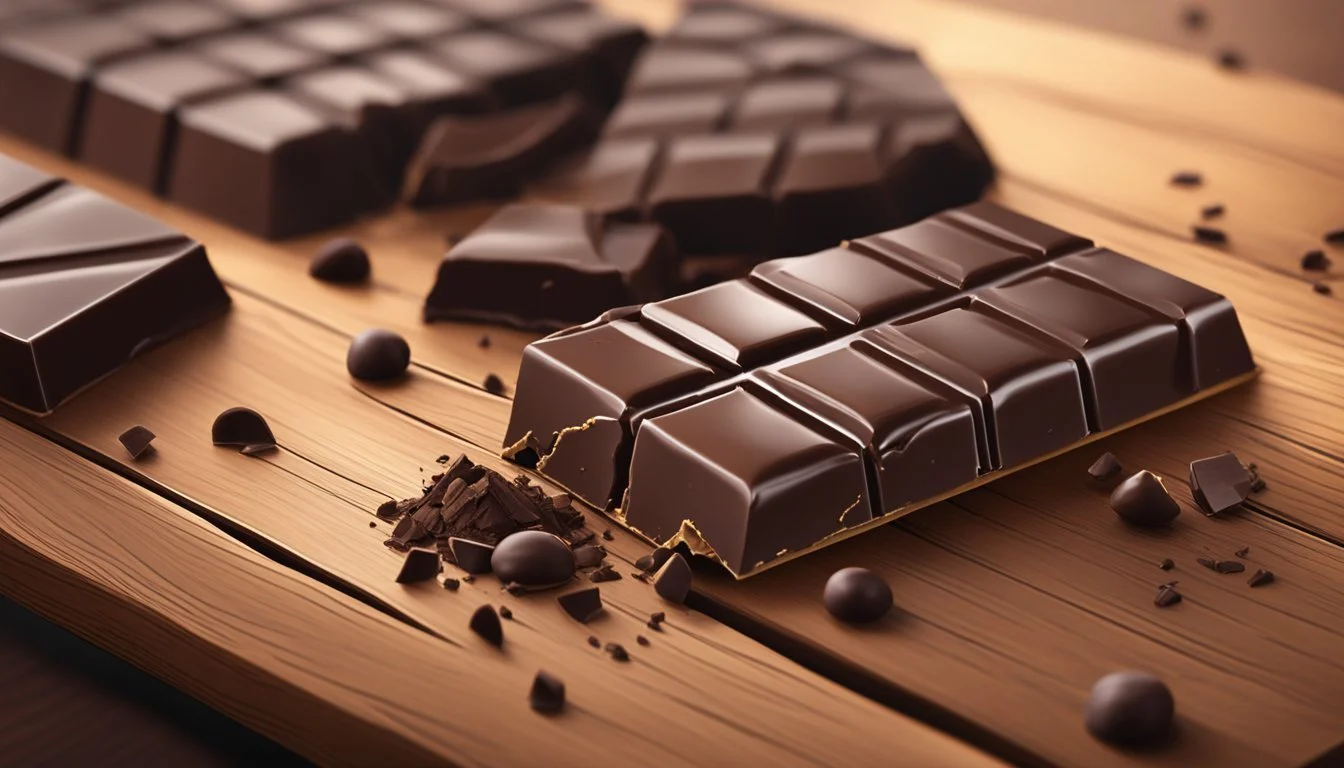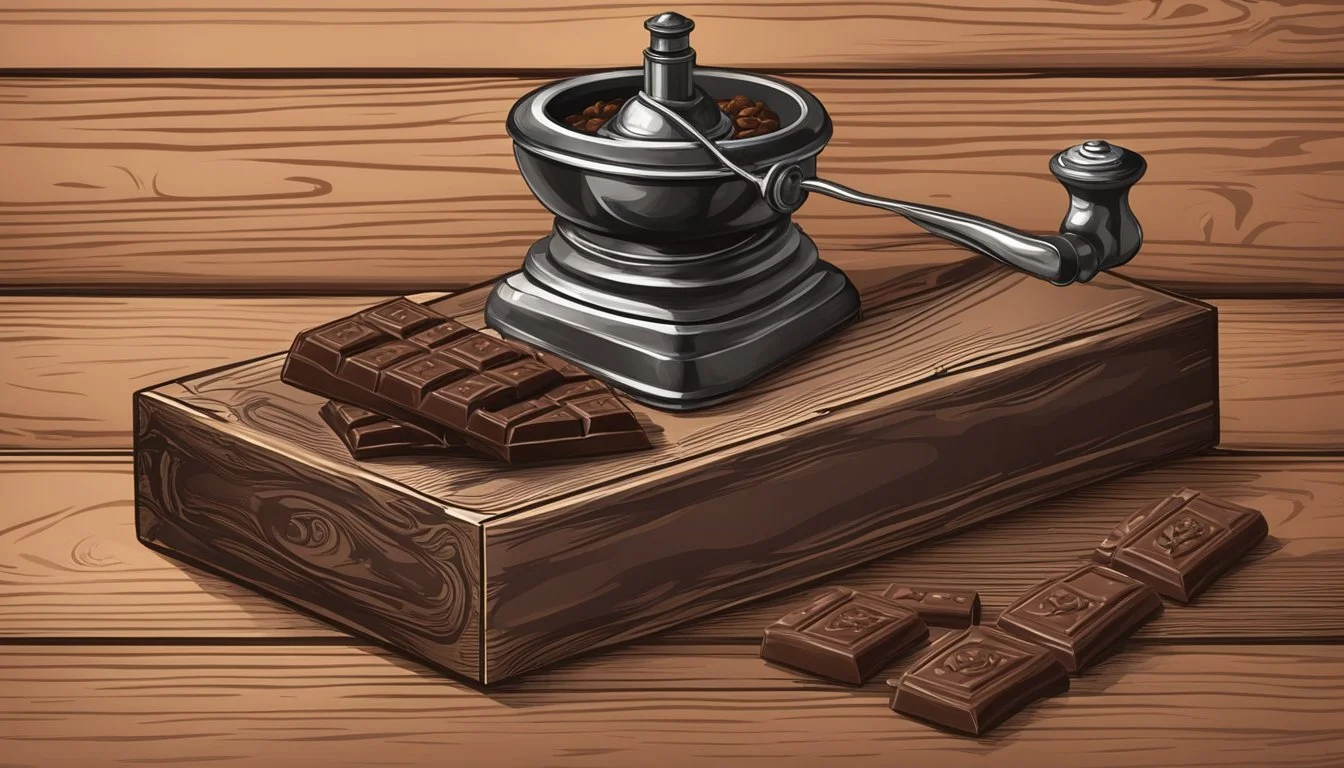Does Dark Chocolate Go Bad?
Shelf Life and Storage Tips
Chocolate lovers often wonder about the shelf life of their favorite treat. Specifically, does dark chocolate go bad? Dark chocolate typically has a longer shelf life compared to milk or white chocolate, thanks to its lower milk content and higher cocoa concentration. Properly stored, dark chocolate can last from one to two years, making it a durable option for long-term enjoyment.
Storage conditions play a crucial role in preserving dark chocolate's quality. Keeping it in a cool, dry place, ideally between 54°F and 61°F, helps maintain its taste and texture. Exposure to heat or humidity can cause it to bloom, a harmless but visually unappealing white coating, which may deter some from eating it.
High-quality dark chocolate, especially those made without artificial preservatives, benefits from age, much like fine wine. The natural flavanols in dark chocolate act as preservatives, helping it retain its flavor and antioxidant properties over time. Thus, understanding the factors affecting its shelf life is key to enjoying dark chocolate at its best.
Understanding Chocolate
Chocolate comes in various types, each with distinct characteristics and compositions. Knowing the differences helps in understanding their shelf life and quality.
Types of Chocolate
Dark Chocolate contains the highest percentage of cocoa solids, ranging from 50% to 90%, which gives it a rich, intense flavor. It has little to no milk solids, contributing to its longer shelf life.
Milk Chocolate includes milk solids, making it creamier and sweeter. It has a lower cocoa content, usually between 10% to 50%, resulting in a shorter shelf life compared to dark chocolate.
White Chocolate lacks cocoa solids entirely and is made from cocoa butter, sugar, and milk. Due to its high milk content, it has the shortest shelf life among the types of chocolate.
Composition of Chocolate
Chocolate is composed of cocoa solids, cocoa butter, and sugar.
Cocoa Solids include the non-fat components of the cocoa bean and are responsible for the chocolate's flavor.
Cocoa Butter is the fat component that gives chocolate its smooth texture.
Chocolate Liquor is a blend of cocoa solids and cocoa butter and is the base for all chocolate types.
Dark Chocolate has a higher cocoa percentage, mostly comprising cocoa solids and cocoa butter, with minimal sugar.
Milk Chocolate includes milk powder or condensed milk, alongside cocoa solids and lower cocoa butter content.
White Chocolate contains no cocoa solids, only cocoa butter, milk, and sugar, making it unique in flavor and texture.
Factors Affecting Chocolate Spoilage
Several factors can influence how quickly dark chocolate spoils. Key elements include temperature and humidity, exposure to air and moisture, and the specific storage conditions used.
Temperature and Humidity
Temperature plays a significant role in chocolate spoilage. Chocolate is best stored at temperatures between 60-68°F (15-20°C). Higher temperatures can cause the chocolate to melt and lose its structural integrity, while lower temperatures may lead to blooming, where fat or sugar crystals appear on the surface.
Equally important is humidity. Keeping the humidity level below 50% helps prevent moisture from getting into the chocolate, which can cause the sugar to dissolve and recrystallize, resulting in a gritty texture.
Maintaining stable temperatures and low humidity can greatly extend the shelf life of chocolate.
Exposure to Air and Moisture
Exposure to air can oxidize the fats in chocolate, making it taste stale or rancid. To minimize air exposure, storing chocolate in an airtight container is essential.
Moisture is another enemy of chocolate. When chocolate comes into contact with moisture, it can develop sugar bloom—a white, powdery appearance caused by the recrystallization of sugar on the chocolate surface. This not only affects the appearance but also the texture and quality of the chocolate.
Using moisture-proof packaging or containers helps ensure the chocolate remains fresh and maintains its quality.
Chocolate Storage Conditions
Proper storage conditions are crucial for preserving chocolate. A pantry or cupboard that is cool, dry, and dark is ideal. Chocolate should be kept away from direct sunlight as UV rays can degrade the flavor and quality.
While the fridge and freezer are options, they are not ideal. Temperature fluctuations in the fridge can cause condensation, leading to sugar bloom.
If chocolate must be frozen, it should be wrapped tightly in moisture-proof material and placed in an airtight container.
Storing chocolate under optimal conditions can significantly prolong its shelf life and maintain its quality.
Identifying Signs of Spoilage in Chocolate
Dark chocolate can spoil, and it's essential to recognize the signs of spoilage to ensure it’s safe to consume. Key indicators include visual changes, alterations in texture, and shifts in odor and taste.
Visual Indicators
Dark chocolate often shows visible signs when it starts to spoil. Look for discoloration such as white spots or gray streaks, commonly known as chocolate bloom. There are two types of bloom:
Fat bloom: Caused by fat rising to the surface, creating greasy, white streaks.
Sugar bloom: Gives the chocolate a grainy, dull appearance due to moisture dissolving sugar on the surface.
Additionally, the presence of mold is a clear indication of spoilage. Any fuzzy, green, or white patches should prompt immediate disposal of the chocolate.
Texture Changes
The texture of dark chocolate changes significantly when it goes bad. Fresh dark chocolate has a smooth, glossy finish and snaps cleanly when broken. Spoiled chocolate may feel grainy or sticky, indicating sugar or fat bloom.
When fat rises to the surface, it not only alters the chocolate’s appearance but also its feel, making it less enjoyable to eat. If the chocolate is soft or has a waxy coating, it’s likely spoiled and should not be consumed.
Odor and Taste Assessment
Odor is another critical factor. Unspoiled dark chocolate has a rich, distinct aroma. Spoiled chocolate may emit an off odor, ranging from rancid to sour or moldy. These unpleasant odors signal that the chocolate is no longer fresh.
Taste also provides clues about spoilage. Dark chocolate should taste bitter-sweet with deep cocoa notes. If it tastes stale, bland, or sour, it’s past its prime. A bitter or metallic taste may indicate that it has gone bad and should be discarded.
By paying close attention to these visual, textural, and sensory cues, one can easily identify when dark chocolate has spoiled.
Shelf Life and Expiration
Understanding the shelf life and expiration of dark chocolate is essential for ensuring its quality and safety. This section will cover how to interpret expiration dates and ways to maximize the shelf life of dark chocolate.
Interpreting Expiration Dates
Dark chocolate often comes with an expiration or "best before" date. These dates are guidelines for peak quality, not absolute deadlines for safety. Typically, unopened dark chocolate can remain at its best for up to two years if stored correctly. Even past this date, it can still be safe to eat, although its texture and flavor may begin to degrade.
When inspecting dark chocolate for usability, look for visual signs of spoilage like discoloration or an off-putting odor. If stored improperly, it may develop a white coating (bloom), which is due to fat or sugar crystals rising to the surface. While bloom affects appearance, it does not make the chocolate unsafe to eat.
Maximizing Shelf Life
Proper storage is crucial in maximizing the shelf life of dark chocolate. Store it in a cool, dry place away from direct sunlight. The ideal temperature range is between 60 to 70 degrees Fahrenheit, with low humidity.
For extended storage, you can refrigerate or freeze dark chocolate, though it should be sealed in an airtight container to prevent moisture absorption and flavor contamination. If freezing, allow the chocolate to return to room temperature gradually to avoid condensation.
Keep chocolate away from strong odors, as it can absorb smells from other foods. By following these storage tips, you can help maintain the quality and flavor of dark chocolate well past its best-by date.
Safe Consumption of Chocolate
Chocolate is a treat that can be enjoyed safely if certain conditions are met. Knowing when chocolate is safe to eat and understanding its health implications ensures a positive and worry-free experience.
When Is Chocolate Safe to Eat?
Chocolate can remain safe to eat for several months beyond its expiration date if stored correctly. Unopened, tightly wrapped chocolate retains its quality longer. Dark chocolate, due to its lower milk content, has a longer shelf life than milk or white chocolate.
The presence of mold makes chocolate unsafe. Mold appears as fuzzy or discolored patches and can produce harmful mycotoxins. Chocolate with gray streaks, known as "chocolate bloom," is safe but may have altered texture and taste. This occurs when fat or sugar crystals rise to the surface.
Storage tips:
Cool, dry place: Keep chocolate in a cool, dry area.
Avoid sunlight: Direct sunlight can cause melting and spoilage.
Airtight container: Use an airtight container to prevent moisture absorption.
Health Considerations
Dark chocolate, rich in antioxidants and flavonoids, offers multiple health benefits when consumed in moderation. These compounds protect the body from oxidative stress and reduce inflammation.
Moderate consumption of dark chocolate can be part of a balanced diet. It's lower in sugar compared to milk chocolate and has a relatively low caffeine content. Be mindful of overall calorie intake, as chocolate can be calorically dense.
Health benefits:
Antioxidants: Protect against free radicals.
Flavonoids: Improve heart health.
Mood enhancement: Promotes the release of endorphins.
Excessive consumption can lead to weight gain and potential health issues. Therefore, enjoy chocolate responsibly within the guidelines of a balanced diet.
Special Cases in Chocolate Storage
Certain types of chocolate require specific storage conditions to maintain their quality, especially those with additional ingredients like fillings or those that are handmade. Proper storage is crucial to preserve the texture, flavor, and appearance of these types of chocolates.
Chocolate with Fillings and Inclusions
Truffles, nuts, dried fruits, and other inclusions make chocolates more susceptible to spoilage due to their perishable contents. These chocolates often have a shorter shelf life compared to pure dark chocolate.
Storage Tips:
Keep them cool (60-68°F) and dry.
Use an airtight container to prevent moisture entry.
Avoid places with strong odors as chocolate absorbs nearby smells.
Common Issues:
Bloom: Fat or sugar bloom may appear, causing a whitish film. While safe to eat, it affects aesthetics.
Texture Changes: Moisture can lead to a gritty texture, especially for chocolates with fillings.
Handmade and Artisan Chocolates
Handmade and artisan chocolates, including Belgian chocolate, often lack the preservatives found in mass-produced varieties, making them more delicate. These chocolates should be treated with extra care to ensure they stay fresh and flavorful.
Storage Tips:
Store in a cool, dry place, ideally with low humidity.
Separate layers with parchment paper to avoid sticking.
Consider refrigerating if the environment is too warm, but allow chocolates to return to room temperature before consuming to prevent condensation.
Details to Note:
Shorter Shelf Life: Handmade chocolates typically last only a few weeks.
Special Packaging: Often comes with protective packaging to maintain freshness.
Flavor Preservation: Proper storage helps retain the complex flavors unique to artisan chocolates.
Practical Tips for Chocolate Lovers
To ensure the best experience with dark chocolate, store it in a cool, dry place. Ideal temperatures range from 60-68°F (15-20°C) with humidity levels below 50%. Avoid placing chocolate near direct heat sources or in sunlight.
Dark chocolate bars and baking chocolate benefit from consistent storage conditions. Moving them between hot and cold environments can cause condensation, leading to chocolate bloom. This harmless phenomenon results in a white, powdery surface appearance due to sugar and fat separation.
Always use airtight containers for storage. Keeping dark chocolate in its original packaging or tightly-wrapped foil helps maintain its rich flavor and quality. For best results, store opened chocolate in resealable bags.
Check for Signs of Spoilage:
Mold: Indicators include fuzzy, green, or white patches.
Texture: Stale chocolate may feel crumbly or dry.
Taste: Spoiled chocolate loses its bitterness and rich flavor, resulting in an off or bland taste.
Here are some quick guidelines for the shelf life of dark chocolate:
Type Shelf Life (Unopened) Shelf Life (Opened) Dark Chocolate Bars Up to 2 years 1 year Baking Chocolate Up to 2 years 1 year
For those with a sweet tooth, semi-sweet chocolate is another option. Similar to dark chocolate, it requires proper storage to prevent spoilage and maintain its slightly sweeter yet still rich profile. Following these tips will help you savor every bite and enjoy the highest quality of your chocolate treats.








